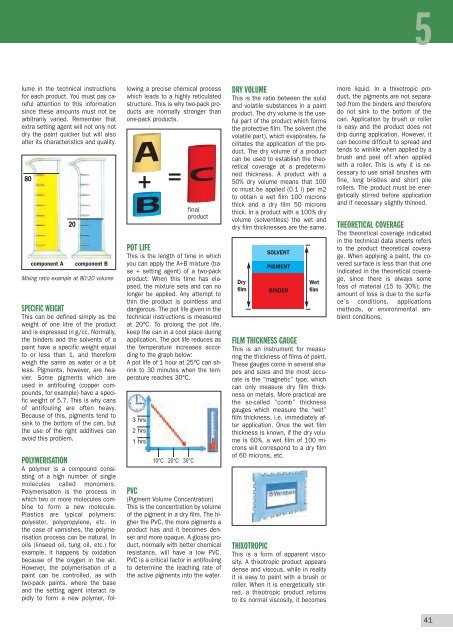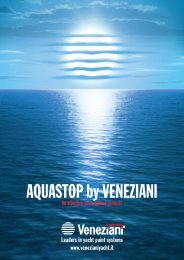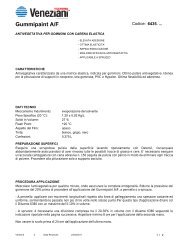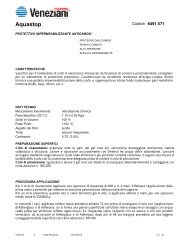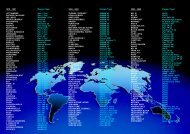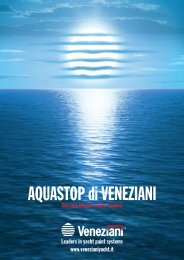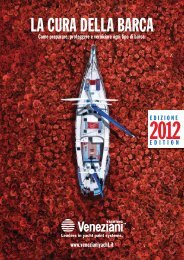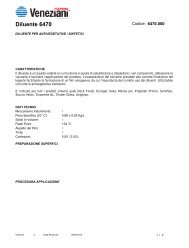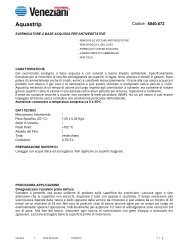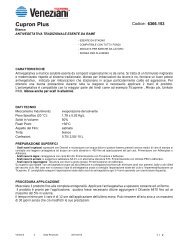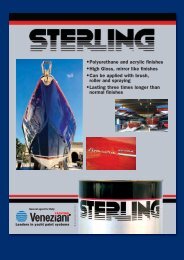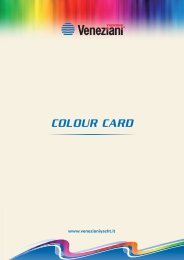3 - Veneziani Yacht Paints
3 - Veneziani Yacht Paints
3 - Veneziani Yacht Paints
You also want an ePaper? Increase the reach of your titles
YUMPU automatically turns print PDFs into web optimized ePapers that Google loves.
lume in the technical instructions<br />
for each product. You must pay careful<br />
attention to this information<br />
since these amounts must not be<br />
arbitrarily varied. Remember that<br />
extra setting agent will not only not<br />
dry the paint quicker but will also<br />
alter its characteristics and quality.<br />
80<br />
20<br />
component A component B<br />
Mixing ratio example at 80:20 volume<br />
SPECIFIC WEIGHT<br />
This can be defined simply as the<br />
weight of one litre of the product<br />
and is expressed in g/cc. Normally,<br />
the binders and the solvents of a<br />
paint have a specific weight equal<br />
to or less than 1, and therefore<br />
weigh the same as water or a bit<br />
less. Pigments, however, are heavier.<br />
Some pigments which are<br />
used in antifouling (copper compounds,<br />
for example) have a specific<br />
weight of 5.7. This is why cans<br />
of antifouling are often heavy.<br />
Because of this, pigments tend to<br />
sink to the bottom of the can, but<br />
the use of the right additives can<br />
avoid this problem.<br />
POLYMERISATION<br />
A polymer is a compound consisting<br />
of a high number of single<br />
molecules called monomers.<br />
Polymerisation is the process in<br />
which two or more molecules combine<br />
to form a new molecule.<br />
Plastics are typical polymers:<br />
polyester, polypropylene, etc. In<br />
the case of varnishes, the polymerisation<br />
process can be natural. In<br />
oils (linseed oil, tung oil, etc.) for<br />
example, it happens by oxidation<br />
because of the oxygen in the air.<br />
However, the polymerisation of a<br />
paint can be controlled, as with<br />
two-pack paints, where the base<br />
and the setting agent interact rapidly<br />
to form a new polymer, fol-<br />
lowing a precise chemical process<br />
which leads to a highly reticulated<br />
structure. This is why two-pack products<br />
are normally stronger than<br />
one-pack products.<br />
POT LIFE<br />
This is the length of time in which<br />
you can apply the A+B mixture (base<br />
+ setting agent) of a two-pack<br />
product. When this time has elapsed,<br />
the mixture sets and can no<br />
longer be applied. Any attempt to<br />
thin the product is pointless and<br />
dangerous. The pot life given in the<br />
technical instructions is measured<br />
at 20°C. To prolong the pot life,<br />
keep the can in a cool place during<br />
application. The pot life reduces as<br />
the temperature increases according<br />
to the graph below:<br />
A pot life of 1 hour at 25°C can shrink<br />
to 30 minutes when the temperature<br />
reaches 30°C.<br />
3 hrs<br />
2 hrs<br />
1 hrs<br />
10°C 20°C 30°C<br />
final<br />
product<br />
PVC<br />
(Pigment Volume Concentration)<br />
This is the concentration by volume<br />
of the pigment in a dry film. The higher<br />
the PVC, the more pigments a<br />
product has and it becomes denser<br />
and more opaque. A glossy product,<br />
normally with better chemical<br />
resistance, will have a low PVC.<br />
PVC is a critical factor in antifouling<br />
to determine the leaching rate of<br />
the active pigments into the water.<br />
DRY VOLUME<br />
This is the ratio between the solid<br />
and volatile substances in a paint<br />
product. The dry volume is the useful<br />
part of the product which forms<br />
the protective film. The solvent (the<br />
volatile part), which evaporates, facilitates<br />
the application of the product.<br />
The dry volume of a product<br />
can be used to establish the theoretical<br />
coverage at a predetermined<br />
thickness. A product with a<br />
50% dry volume means that 100<br />
cc must be applied (0.1 l) per m2<br />
to obtain a wet film 100 microns<br />
thick and a dry film 50 microns<br />
thick. In a product with a 100% dry<br />
volume (solventless) the wet and<br />
dry film thicknesses are the same.<br />
Dry<br />
film<br />
SOLVENT<br />
PIGMENT<br />
BINDER<br />
Wet<br />
film<br />
FILM THICKNESS GAUGE<br />
This is an instrument for measuring<br />
the thickness of films of paint.<br />
These gauges come in several shapes<br />
and sizes and the most accurate<br />
is the “magnetic” type, which<br />
can only measure dry film thickness<br />
on metals. More practical are<br />
the so-called “comb” thickness<br />
gauges which measure the “wet”<br />
film thickness, i.e. immediately after<br />
application. Once the wet film<br />
thickness is known, if the dry volume<br />
is 60%, a wet film of 100 microns<br />
will correspond to a dry film<br />
of 60 microns, etc.<br />
THIXOTROPIC<br />
This is a form of apparent viscosity.<br />
A thixotropic product appears<br />
dense and viscous, while in reality<br />
it is easy to paint with a brush or<br />
roller. When it is energetically stirred,<br />
a thixotropic product returns<br />
to its normal viscosity, it becomes<br />
5<br />
more liquid. In a thixotropic product,<br />
the pigments are not separated<br />
from the binders and therefore<br />
do not sink to the bottom of the<br />
can. Application by brush or roller<br />
is easy and the product does not<br />
drip during application. However, it<br />
can become difficult to spread and<br />
tends to wrinkle when applied by a<br />
brush and peel off when applied<br />
with a roller. This is why it is necessary<br />
to use small brushes with<br />
fine, long bristles and short pile<br />
rollers. The product must be energetically<br />
stirred before application<br />
and if necessary slightly thinned.<br />
THEORETICAL COVERAGE<br />
The theoretical coverage indicated<br />
in the technical data sheets refers<br />
to the product theoretical coverage.<br />
When applying a paint, the covered<br />
surface is less than that one<br />
indicated in the theoretical coverage,<br />
since there is always some<br />
loss of material (15 to 30%); the<br />
amount of loss is due to the surface’s<br />
conditions, applications<br />
methods, or environmental ambient<br />
conditions.<br />
41


